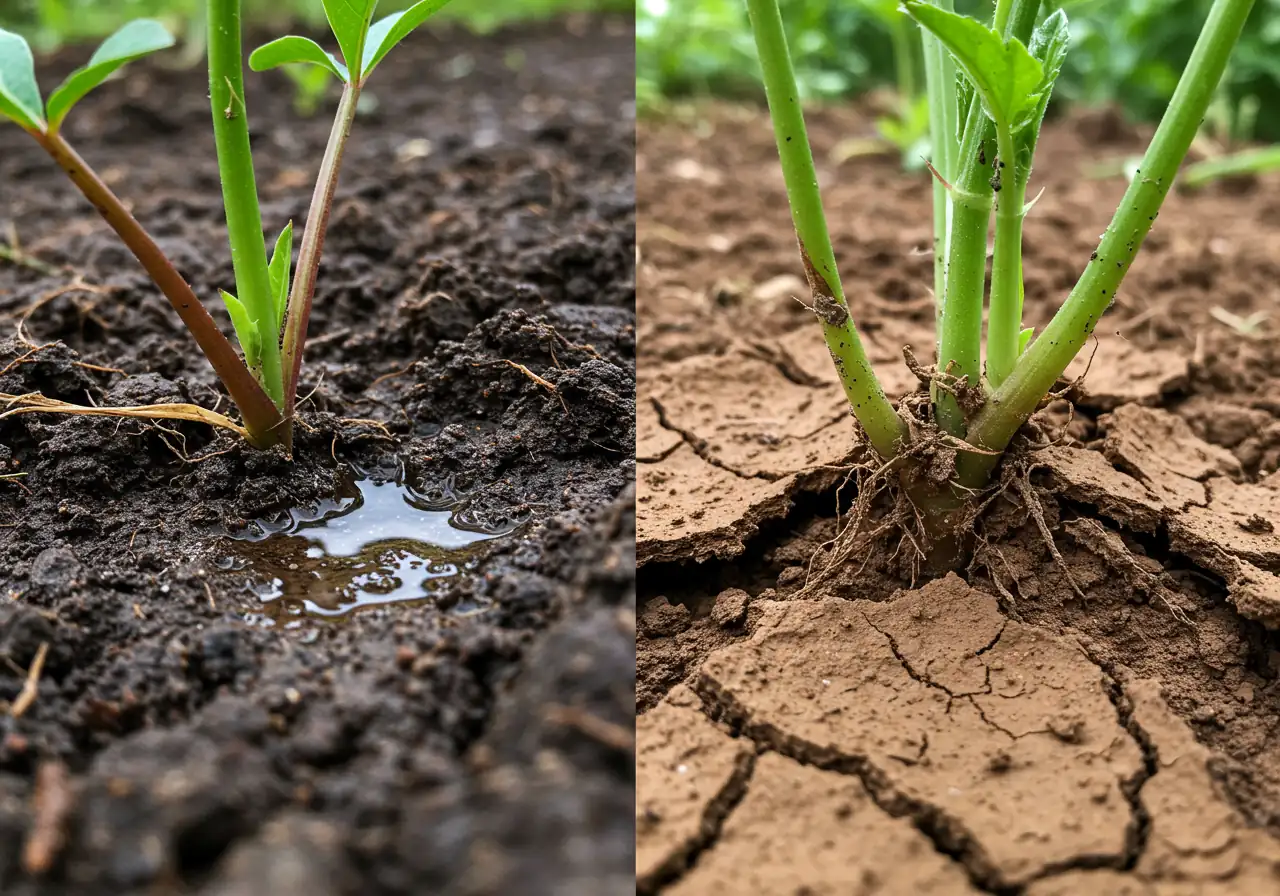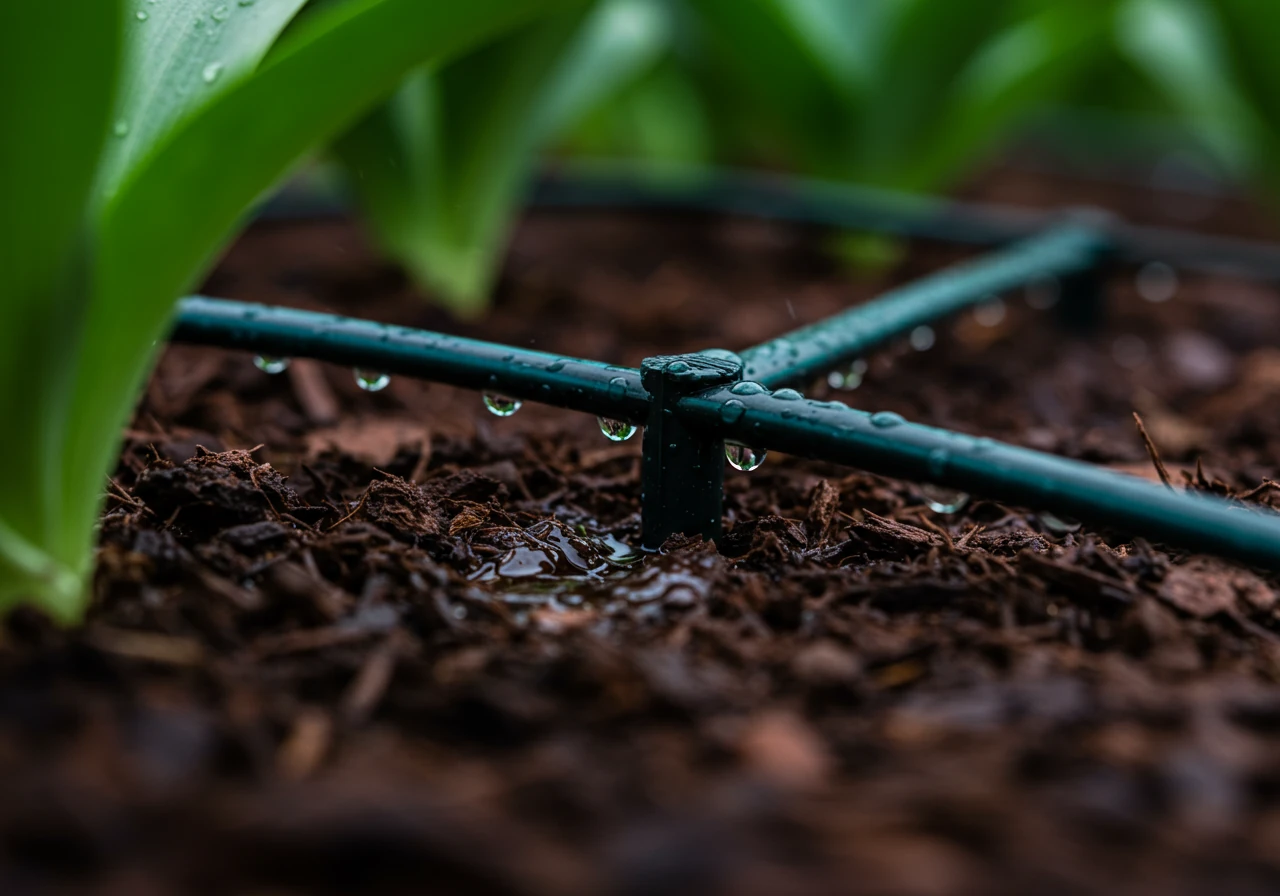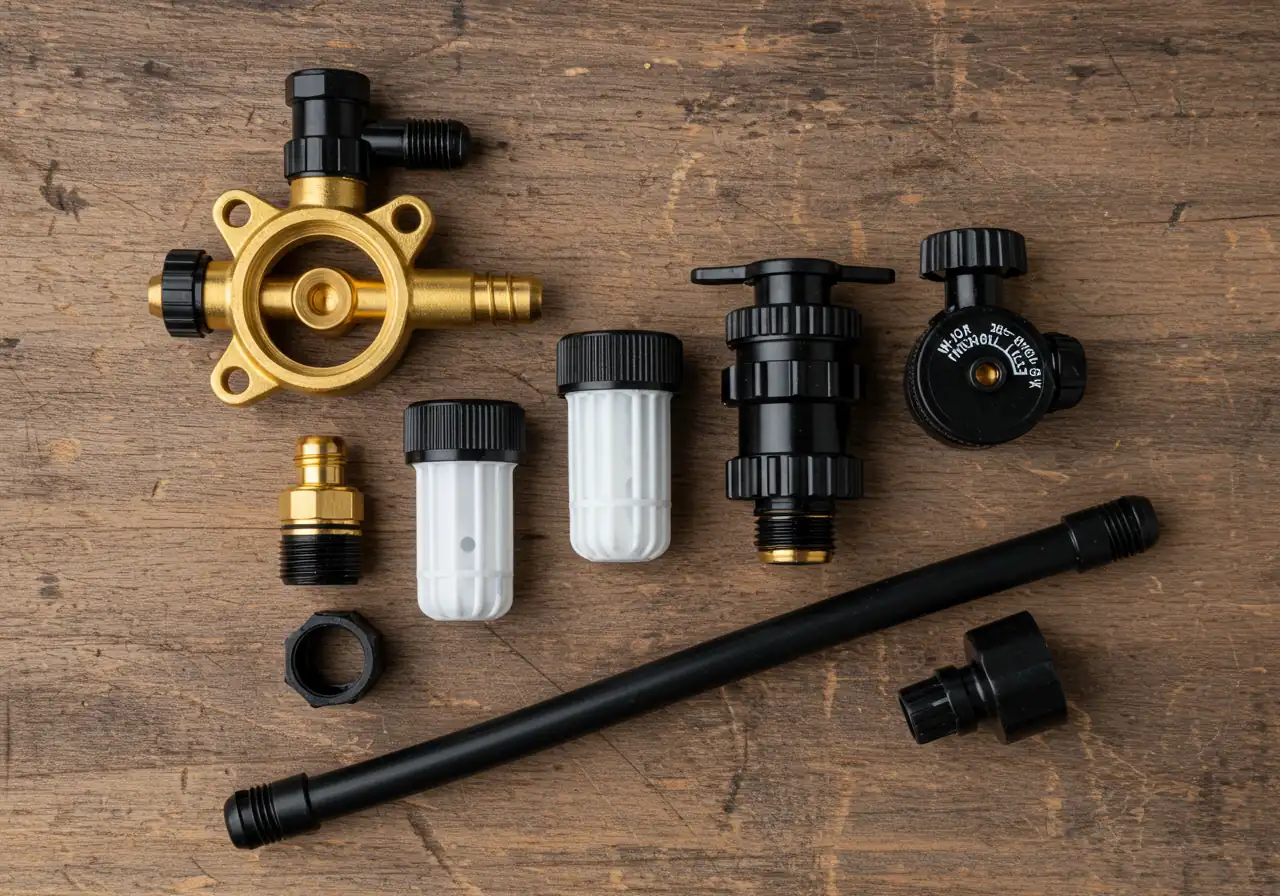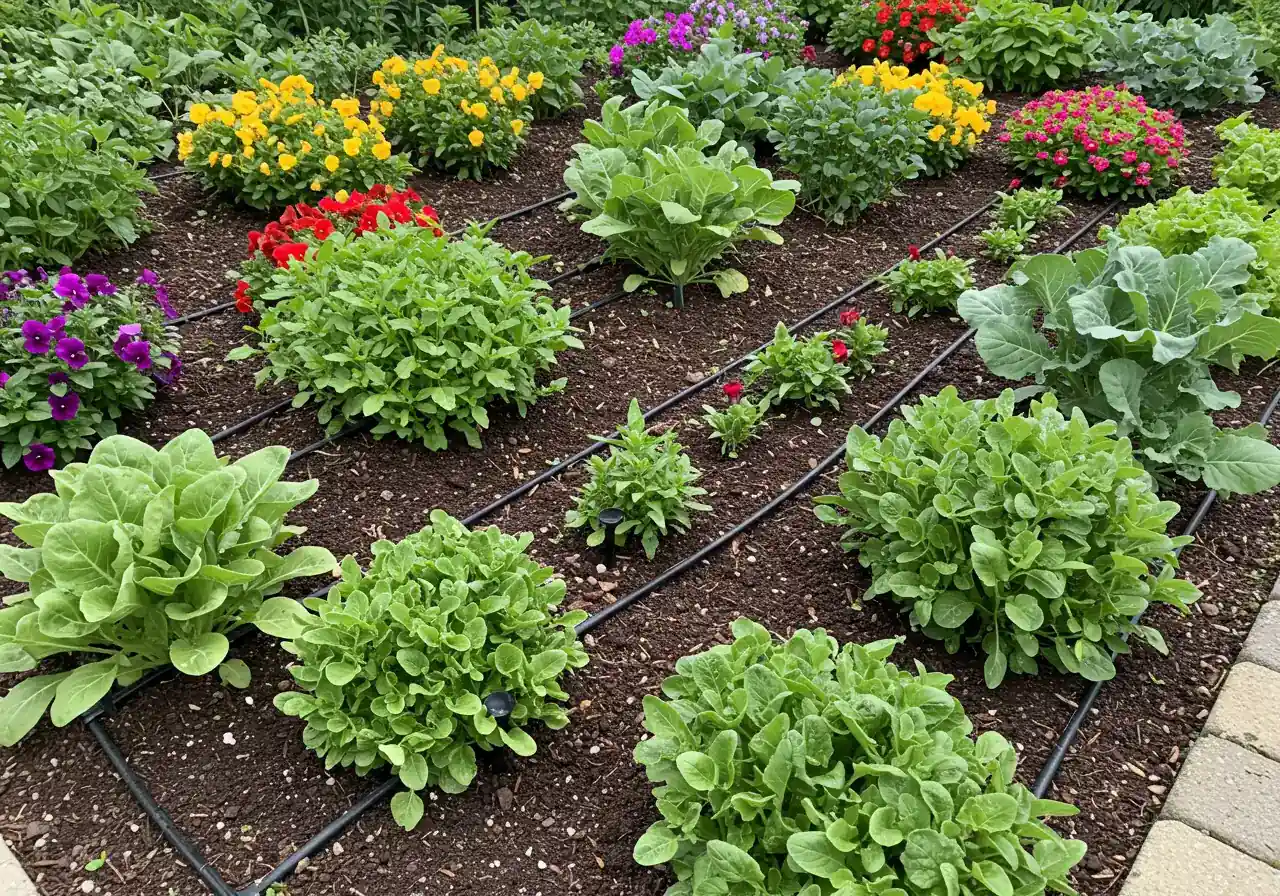Russell Drip Irrigation Install: Save Water on Clay Soil
Struggling with watering your Russell garden on heavy clay soil? Drip irrigation offers a smart, water-saving solution. Ready for healthier plants and less hassle? Request a free estimate today!
Quick Takeaways:
- Drip irrigation is ideal for Russell's heavy clay soil, preventing runoff and promoting deep watering.
- It significantly conserves water compared to traditional sprinklers (up to 90% efficiency).
- Leads to healthier plants by delivering water directly to the root zone.
- Reduces weed growth by keeping surrounding soil dry.
- Requires seasonal maintenance, especially winterization in the Ottawa climate.
- Can be a DIY project or professionally installed for optimal results.
Introduction: Watering Woes in Russell? Drip Irrigation to the Rescue!
Hello Russell homeowners! Finding your garden watering routine more work than wonder? One minute you're watering, the next you've created surprise mini-ponds on your lawn or between your precious plants. Or, wait a day, and the ground resembles cracked pottery! Welcome to the joys (and sometimes frustrations!) of gardening with the heavy clay soil common here in Russell, and indeed many areas around Ottawa like neighbouring Embrun or Metcalfe.
This type of soil is actually great at *holding* water once it gets in, but it can be terribly slow to absorb it. This often leads to wasteful runoff rolling away from your thirsty plants, or those dreaded extremes: soggy mud puddles or rock-hard, cracked earth when it finally dries out. If this sounds like your landscaping reality, you're definitely not alone!
But don't hang up your gardening gloves just yet. There's a brilliant solution tailor-made for these tricky conditions: drip irrigation. It's a super-efficient way to deliver water slowly, steadily, and precisely right where your plants' roots need it most. Ready to say goodbye to watering woes and hello to healthier gardens and potentially lower water bills? Let's explore how drip irrigation can rescue your Russell garden!
The Clay Soil Conundrum: Why Your Russell Garden Needs a Different Drink

Okay, fellow Russell gardeners, let's talk dirt! Specifically, let's chat about the heavy clay soil that gives many of us in the Ottawa region – from right here in Russell to our neighbours down the road in places like Greely or Metcalfe – a unique set of landscaping challenges. Now, clay soil isn't *bad*; it's actually packed with nutrients, which is great! But when it comes to giving your garden a drink, this soil type can be, well, a bit stubborn.
Imagine clay soil as a super dense sponge, or maybe even a block of slightly damp modelling clay. Its particles are incredibly tiny and stick together very tightly. This means water has a really hard time soaking in quickly. Ever tried pouring water onto a mostly dry brick? Sometimes, watering heavy clay feels just like that, especially if the ground has dried out. Instead of sinking down to the roots where it's needed, the water often just pools on the surface or worse, runs off entirely, sometimes taking valuable topsoil with it. This runoff is a common headache during sudden summer downpours or when using traditional sprinklers that apply water faster than the clay can absorb it.
Then there's the other side of the coin. *Once* clay soil does get thoroughly wet, it holds onto that moisture like a determined toddler holding onto a favourite toy. While good water retention sounds beneficial, it can easily lead to soggy, waterlogged conditions. Plant roots need oxygen as much as water, and they can essentially drown if the soil stays saturated for too long. Plus, walking on wet clay or using equipment compacts it easily, squishing those tiny particles even closer together. This compaction makes it even *harder* for water to penetrate and for roots to grow happily. Keeping grass healthy requires specific strategies, something we delve into in our guide covering the secrets to perfect Russell lawn care.
This all leads to a frustrating cycle for gardeners: the soil is either overly wet and potentially compacted, or it dries out into something resembling concrete, complete with cracks. Neither extreme is ideal for thriving plants! Tackling these conditions often requires specific approaches, like adopting methods detailed in Russell organic lawn care for clay soil summer tips. Even routine garden tasks can be affected; for instance, compacted clay can make it trickier to determine when to divide perennials in Russell to prevent spring overcrowding as roots can be tough to separate. Proper watering influences everything, including the success of specific flowering plants, which is why knowing things like these Ottawa & Russell lupin deadheading garden tips goes hand-in-hand with understanding your soil. You can view some great results in our gallery.
Clearly, the typical powerful blast from a garden hose or the wide, fast spray from many sprinklers isn't the most efficient "drink" for our particular type of soil here in Russell. We need a watering method that’s gentler, slower, and smarter to effectively quench our clay soil's thirst without causing runoff or waterlogging. If navigating the challenges of clay soil feels like more than you bargained for, remember that professional help is available through various landscaping and garden care services designed to manage these exact conditions.
Drip Irrigation Demystified: Slow, Steady, and Smart Watering

Alright, let's pull back the curtain on drip irrigation! It sounds fancy, but the concept is wonderfully simple. Think of it less like a firehose trying to fill a thimble (which is kinda what happens when sprinklers hit dense clay soil!) and more like giving each plant its own personal hydration station, delivering water sip by sip.
So, how does this magic work? A drip irrigation system is basically a network of thin tubes or hoses laid across your garden beds, close to your plants. These tubes have tiny holes or specialized outlets called emitters spaced along their length. When you turn on the water, it flows through the tubes and *drips* out slowly and directly onto the soil surface, right near the base of each plant. No dramatic spray, no wasted water flying through the air – just a gentle, targeted delivery.
Why is this "slow and steady" approach the superhero your clay soil has been waiting for? Remember how we talked about clay being slow to absorb water? Drip irrigation matches that pace perfectly. By delivering water slowly, it gives the soil time to soak it up properly, minimizing runoff and ensuring the moisture penetrates deep down to the root zone where plants actually need it. This prevents the frustrating cycle of surface pooling followed by rapid drying and cracking. It also means less risk of creating those soggy, oxygen-deprived conditions that roots absolutely hate.
Drip Irrigation vs. Traditional Sprinklers (Especially on Clay Soil)
| Feature | Drip Irrigation | Traditional Sprinklers |
|---|---|---|
| Water Efficiency | Very High (up to 90% efficient). Water goes straight to the roots. | Lower (50-70% efficient). Lots lost to wind, evaporation, and runoff. |
| Runoff Risk (on Clay) | Very Low. Slow application allows absorption. | High. Water applied faster than clay can absorb. |
| Evaporation Loss | Minimal. Water applied directly to soil. | Significant. Water sprays through the air. |
| Targeting Accuracy | Precise. Waters only the root zone. | Broad. Waters plants, paths, weeds, everything. |
| Soil Compaction Risk | Low. Gentle application doesn't pound the soil. | Higher. Force of water can compact wet clay over time. |
| Weed Growth | Reduced. Only areas near plants are watered. | Encouraged. Waters entire area, feeding weeds too. |
The benefits are pretty clear! You save water (which is great for your wallet and the environment), your plants are healthier because they get consistent moisture right where they need it, and you'll likely see fewer weeds popping up in the dry spaces between plants. Whether you have delicate flower beds in Barrhaven, a thriving vegetable patch in Manotick, or young trees getting established in Metcalfe, drip irrigation is incredibly versatile. Keeping these systems running smoothly can be part of regular garden maintenance; many homeowners find it helpful to bundle this with seasonal work like an Ottawa garden clean-up service or a more specific Russell garden clean-up service. For those in surrounding areas, similar support like a Metcalf property cleanup service can ensure your watering system and garden beds stay in top shape. Setting up drip can be a DIY project, but professional installation ensures optimal layout and efficiency, often included within broader landscaping and garden care services. Some systems even connect to smart timers, though it's always wise to check the company's privacy policy regarding any data collected. Drip irrigation truly is a smarter way to water, especially for our challenging Ottawa-area soils. Need help getting started? Check out our Google Business Profile for reviews and contact info.
Installation Approaches Compared
DIY Drip Irrigation Install
Tackling the installation yourself can be rewarding and cost-effective if you enjoy hands-on projects.
- Pros: Lower upfront cost (materials only), learn your system intimately, flexibility to modify.
- Cons: Requires time investment for research and labor, potential for mistakes (leaks, incorrect spacing), physical effort.
- Best For: Smaller gardens, specific zones (like veggie patches or containers), budget-conscious homeowners who like projects.
Remember to plan carefully, especially concerning soil preparation and winterization needs.
Professional Drip Irrigation Install
Hiring experts ensures efficient design and correct installation tailored to your landscape's specific needs.
- Pros: Saves time, leverages expertise for optimal layout/efficiency, often includes warranty, integration with other services like mulching and edging.
- Cons: Higher upfront cost due to labor and expertise.
- Best For: Larger or complex landscapes, homeowners short on time, those wanting guaranteed results and potential ongoing maintenance support via options like a customer portal.
A professional install ensures your garden gets the best start, potentially leading to stunning transformations.
Planning Your Russell Drip System: Setting Up for Success

Okay, let's roll up our sleeves and get down to planning! You've decided drip irrigation is the way to go for your Russell garden – fantastic choice! A little bit of planning now saves a *lot* of head-scratching (and maybe some hose-wrangling frustration) later. Think of it as creating the perfect roadmap for happy, hydrated plants.
Steps for Effective Planning:
- Know Your Zones: Not all plants are created equal when it comes to thirst! Your tomatoes might need more frequent sips than your established shrubs. Your sunny flower border in Greely will have different needs than a shady hosta patch in Manotick. Sketch out your garden areas. Label them: veggie patch, front flower bed, shrub border, container pots, etc. Group plants with similar watering needs together mentally – these will become your different "zones." This is also the perfect time to tidy up! Clearing weeds and debris makes planning (and eventual installation) much easier. If the beds need more than a quick tidy, consider getting help with an Ottawa garden clean-up service to get a clean slate.
- Map it Out (Roughly!): Draw a simple map of your yard. It doesn't need to be a masterpiece! Show the house, pathways, existing garden beds, and any trees or large shrubs. Mark where your outdoor water faucet (spigot) is located – this is your starting point. Now, pencil in where you think the main water line tubing will run from the faucet, and where smaller "branch" lines will peel off to water each zone you identified. Think about where emitters (the drippy bits) will need to go for each plant. Are you planning a brand new garden area? Integrating drip irrigation from the start is ideal, especially if you're considering a professional garden install service.
- Water Source Check-in: Head over to your outdoor faucet. Most drip systems connect right here. You'll likely need a backflow preventer (crucial for safety!), a filter (to prevent clogs), a pressure regulator (drip systems like lower pressure than your typical hose), and maybe a timer (for automatic watering bliss!). It's also good to have a rough idea of your home's water pressure, though the regulator will handle adjustments. Check out options for material selection for durable components.
- Think Ahead to Winter: This is Ottawa, folks! Winter happens. Your drip system *must* be winterized to prevent frozen pipes and cracked components. When planning your layout, think about how you'll drain or blow out the system in the fall. Usually, this means ensuring lines slope gently for drainage or having accessible connection points for an air compressor. Planning this now saves major headaches later. If you're getting professional help, make sure winterization is part of the discussion. You can often track service schedules, like winterization appointments, through tools like our customer portal.
- Consider Other Projects: Are you putting in a new lawn soon? Planning your irrigation alongside projects like sod installation can help integrate everything smoothly, potentially burying main lines before the grass goes down.
Simple Planning Checklist:
- Walk your yard & identify all planting areas.
- Group plants into zones based on water needs (sun vs. shade, veggies vs. shrubs).
- Sketch a basic map showing faucet location, zones, and potential tubing routes.
- Locate your water source; note requirements (backflow preventer, filter, regulator, timer).
- Estimate rough tubing lengths and number of emitters needed.
- Think about winterization access points.
- Get necessary components: tubing, emitters, connectors, stakes, hole punch, etc. For help estimating, use our estimate feedback form.
Taking these steps will set you up for a successful drip irrigation system that keeps your Russell garden thriving. If it feels overwhelming, don't hesitate to seek expert advice or installation help from trusted local professionals. Happy watering!
DIY Delight or Professional Precision? Installing Your Drip System
Okay, so you're sold on the wonders of drip irrigation for your Russell garden. Fantastic! Now comes the big question: do you tackle the installation yourself, embracing your inner weekend warrior, or call in the cavalry for some professional precision? Both paths have their perks, kind of like choosing between baking your own bread (rewarding, maybe a bit messy) or grabbing a perfect loaf from the local bakery (quick, guaranteed delicious). Let's break down the options to help you decide.
DIY Delight: The Hands-On Approach
Pros:
- Cost Savings: Let's be honest, this is often the biggest draw. You're primarily paying for materials, not labor.
- Sense of Accomplishment: There's definite satisfaction in stepping back and saying, "I did that!" You'll know your system inside and out.
- Flexibility: Want to tinker and adjust as you go? Doing it yourself gives you complete control over the process, piece by piece.
Cons & Considerations:
- Time Commitment: Researching, buying parts, and the actual installation takes time – potentially several hours or even a weekend, depending on the garden size.
- Learning Curve: While not rocket science, there's still a learning curve. Understanding pressure regulation, emitter spacing for clay soil, and proper connections is key. Mistakes might mean leaks or inefficient watering. Check our terms and conditions for service details if considering pro help later.
- Potential for Oopsies: Cutting tubing too short, punching holes in the wrong places… it happens! Troubleshooting can sometimes turn into a frustrating hose-wrestling match.
- Physical Work: It involves some digging (though usually shallow), kneeling, and connecting small parts.
DIY Tip: Start small! Maybe tackle just one garden bed first to get the hang of it before expanding. Follow kit instructions closely, and don't skimp on essential components like filters and pressure regulators. After you're done, you might still need a bit of tidying – a general Ottawa property clean up can help get things looking sharp again.
Professional Precision: Calling in the Experts
Pros:
- Expertise & Efficiency: Pros know the ropes. They understand soil types (like our lovely Russell clay!), plant needs, and optimal layouts for efficient watering. They've seen it all, from straightforward beds in Kenmore to complex landscapes in Vernon or Marionville.
- Time Savings: What might take you a weekend, they can often knock out much faster, letting you enjoy your garden sooner.
- Proper Design & Installation: They'll ensure correct zoning, pressure, and emitter placement for *your* specific yard, maximizing water savings and plant health. This is crucial for achieving significant garden transformations.
- Warranty & Support: Reputable installers often guarantee their work and materials. Plus, they can handle future maintenance or troubleshooting, sometimes managed through a handy customer portal for scheduling.
- Integration: Professionals can easily integrate drip irrigation with other services, like existing sprinkler systems or comprehensive lawn care programs.
Cons & Considerations:
- Higher Upfront Cost: You're paying for expertise, labor, and convenience, so the initial investment is higher than DIY.
- Scheduling: You'll need to schedule the installation work.
Pro Tip: Get a few quotes! Ensure the company understands your needs and the specifics of your Ottawa-area property. Ask about the components they use and if winterization service is included or available. Ready to explore this option? You can easily book a free estimate to discuss your project.
Making the Choice
So, DIY or pro? If you enjoy hands-on projects, have a relatively simple garden layout, and the time to invest, DIY can be a rewarding experience. But if your garden is large or complex, you're short on time, or you simply want the peace of mind that comes with expert installation and ongoing support, calling a professional is likely your best bet. Either way, you're investing in a smarter, more efficient way to water your garden – and your plants will thank you for it!
Estimated Water Savings: Drip vs. Sprinkler
Illustrative comparison showing significantly lower water loss (evaporation, runoff) with Drip Irrigation compared to traditional sprinklers on clay soil.
Keeping the Drip Flowing: Seasonal Maintenance for Ottawa Winters & Summers
Seasonal Drip Maintenance Schedule
Spring Awakening (After Frost Risk)
Reconnect system (backflow, filter, regulator). Flush main lines. Check for leaks & critter damage. Clean/replace filter. Test emitters. Bundle with spring yard cleanup!
Summer Sipping Season
Monitor emitters for clogs. Adjust watering schedule based on rain/heat. Observe plants for stress signals. Essential part of ongoing garden maintenance.
Fall Shutdown & Winter Prep (CRUCIAL!)
Disconnect *everything* from faucet before first hard freeze. Drain/blow out all water from lines using low-pressure air. Cap ends. Store sensitive parts indoors. Coordinate with fall services like Marionville garden clean up or Metcalf garden clean up.
Ongoing Checks
Periodically check for leaks at fittings. Clear clogged emitters gently (pin/toothpick). Ensure filter is clean. Consider adding a rain sensor for extra water savings.
Performing these simple checks keeps your drip irrigation system efficient and reliable season after season. For guidance on durable components, refer to our material selection tips. If tackling maintenance feels overwhelming, or if you run into stubborn problems, remember that expert help is available. Feel free to contact us to discuss maintenance plans or troubleshoot issues!
For reputable gardening resources in the Ottawa area, check out the Friends of the Central Experimental Farm or the Master Gardeners of Ottawa-Carleton.
Highlight Box: Drip Irrigation Quick Wins for Russell Gardeners

Dealing with Russell's heavy clay soil feels like a gardening puzzle sometimes, doesn't it? Too wet, too dry, never just right! Drip irrigation is your secret weapon. Here are some quick wins:
- Conquer Clay Crud: Stop wasting water to runoff! Drip irrigation delivers water *slowly*, giving stubborn clay soil time to actually absorb it down to the roots.
- Water Smarter, Not Harder: Highly efficient (up to 90%), putting water exactly where plants need it, saving time, effort, and potentially money. Check our services page for installation options.
- Boost Plant Health: Consistent, deep watering encourages strong root growth. Maximize benefits with good soil preparation.
- Weed Less, Enjoy More: Only waters plant zones, not bare soil where weeds sprout. Your plants send a silent thank you!
- Don't Forget the Freeze! Crucial for Ottawa: *Always* winterize before frost. Drain/blow out lines. Combine with an Ottawa yard cleanup service.
- Start Simple or Call the Pros: DIY kits work for small beds. For larger areas or expert setup, professional help is available, whether in Russell or needing a Marionville property cleanup service approach.
Your Russell Drip Irrigation Questions Answered (FAQ)
That's a fair question! Think of drip irrigation as an investment rather than just an expense. While there's an upfront cost for materials (tubing, emitters, filter, etc.) and potentially installation if you hire pros, the long-term savings can be significant. You'll likely use *much* less water – sometimes cutting water use for your garden beds by 50% or more compared to traditional sprinklers. Less water waste means lower water bills over time. Plus, your plants will be healthier thanks to getting water right where they need it, which means less money spent replacing stressed or unhappy plants. For many homeowners in Russell and surrounding areas like Embrun or Metcalfe, the water savings and improved garden health make it a very worthwhile upgrade, adding value to their landscaping efforts.
Ah, the clay soil conundrum! It’s actually *why* drip irrigation is such a superstar in areas like Russell, Greely, and Osgoode. Traditional sprinklers often blast water faster than our dense clay can absorb it, leading to pooling and wasteful runoff. Drip irrigation works differently. It releases water *very slowly*, drop by drop, right at the base of your plants. This gentle, slow delivery gives the clay soil enough time to actually soak up the moisture effectively, letting it penetrate deeper towards the roots instead of sliding off the surface. So, less mud, less waste, and happier plant roots!
Absolutely, but it requires a little seasonal care – think of it like putting away your patio furniture. The key is *winterization*. Before the hard freezes hit (usually mid to late fall in the Ottawa region), you *must* disconnect the system from the faucet, drain it thoroughly, and ideally use an air compressor to blow out any remaining water from the lines. This prevents water from freezing, expanding, and cracking the tubing or emitters. Storing sensitive parts like timers indoors is also wise. Come spring, you reconnect, flush the lines, and check for any critter damage or leaks. Keeping the system clear is important, much like how a proper fall cleanup sets your garden up for success; some folks even coordinate winterizing their drip system with services like a Metcalf yard clean-up service to get all the autumn tasks done efficiently. During hot summers, the durable tubing holds up well, just ensure your watering schedule matches the weather.
It can be either! Many handy homeowners successfully install their own drip systems, especially for smaller garden beds or container setups. Kits are available, and the process mainly involves laying out tubing, punching holes, inserting emitters, and connecting everything to your faucet (with a filter and pressure regulator!). It does take time and a bit of planning. However, for larger or more complex landscaping layouts, or if you simply prefer guaranteed results and want to save time, professional installation is a great choice. Experienced installers understand optimal layouts for different plant needs and soil types, ensuring maximum efficiency. If you're considering professional help, you can learn more about us and our experience with Ottawa-area gardens.
Yes, most homeowners see a noticeable drop! Sprinklers, especially older models, can be quite inefficient. A lot of water gets lost to evaporation before it even hits the ground, gets blown away by wind, or runs off surfaces that don't need watering (like paths or driveways). Drip irrigation delivers water directly to the soil surface near the roots with minimal loss. Estimates vary, but efficient drip systems can use 30% to 50% less water than conventional sprinklers for the same garden area. Consistent checks are part of good garden maintenance, ensuring emitters aren't clogged and the system runs efficiently to maximize those water savings.
Generally, Ottawa and its surrounding townships encourage water conservation, especially during dry summer months. While there can be restrictions on *when* you can use traditional lawn sprinklers (like odd/even days), water-efficient methods like drip irrigation are often exempt from these time-of-day rules because they waste so little water. However, it's *always* a good idea to check the latest guidelines directly on the City of Ottawa website (see their seasonal water demands page) or your local township's site (like Russell township) as regulations can sometimes change. Using drip irrigation is usually seen as a responsible, water-wise gardening practice! It complements other eco-friendly efforts, similar to how a good seasonal cleanup, like a thorough Marionville yard clean-up service, prepares the ground for healthy, sustainable growth.
Conclusion: Give Your Russell Garden the Gift of Smart Watering
So there you have it – the inside scoop on making your Russell garden thrive with drip irrigation! It really is like giving your plants a personal hydration system, perfectly suited for tackling our infamous clay soil. Forget watching precious water run down the driveway; drip irrigation delivers slow, steady sips right to the roots. That means healthier, happier plants, less water waste (your wallet might thank you!), and fewer weeds crashing the party. From Osgoode to Greely and right here in Russell, it's a game-changer for local gardening. Just remember that simple fall winterizing step to keep it safe through Ottawa's chilly winters!
Ready to give your garden the gift of smart watering this season? It's easier than you think, and the rewards of a flourishing, efficiently watered landscape are well worth it. Let us help your Russell garden look its absolute best!
- Get a personalized quote: Contact us today to discuss your specific landscaping needs and get a free, no-obligation estimate.
- See the results: Browse our gallery of stunning garden transformations to get inspired by what's possible.
- Have questions? We're happy to chat! Give us a call or send a message to learn more about smart watering solutions for your property and check our property clean up services too.

